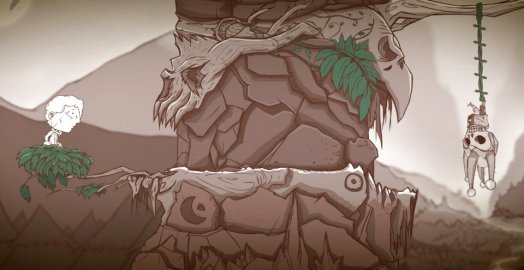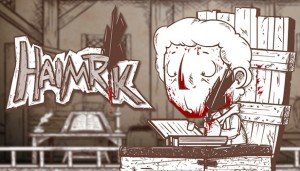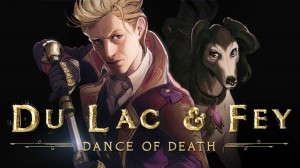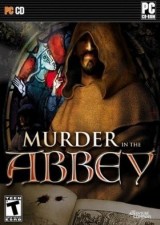Review for Haimrik

Puzzles may be a staple of traditional adventure games, but they can also be effectively incorporated into whole different genres in new and creative ways. Case in point: Haimrik, Below the Game’s unique puzzle-platformer that takes players through an engaging fantasy story with a small but memorable cast of characters, and fun yet tricky word-based problems all presented in a beautifully somber, cartoony art style.
The tale takes place in a medieval-type realm filled with warriors of both might and magic. Long ago, when an evil force attacked the four kingdoms of Estria, a man named King Udolf united them together and fought off the invaders with the ancient power to summon objects and spells through the words of powerful books. The group of heroes who wielded this power were revered as the “Word Warriors”. Now, many years after the war, a young scribe by the name of Haimrik is living in the poor town of Sinisa, where he finds a strange book that transports him to the world within its pages when he writes in it with his own blood instead of ink. Shortly after, however, he’s attacked by one of the Word Warriors, which convinces him he needs to find out where this book came from and why he found it on his desk.
One of the game’s greatest aspects is its storytelling. The script has a sense of humour, conveyed mostly through the way characters (even friends) make fun of Haimrik for looking (and acting) the part of a meek peasant, along with a few visual gags like a drunkard very clumsily trying to throw up off the side of a cliff. The imagery of these cute caricatures in dramatically dangerous situations – some of them being gored or suffering other painful ends – is also part of the comedy. Between jokey bits, however, the overarching story tells a more serious story filled with royal conspiracy, betrayal and deadly secrets. It’s even a somewhat sorrowful tale that has some good plot twists in the second half to spice things up. Helping to suspend disbelief in otherwise unbelievable circumstances, the various characters talk like actual people, with realistic (and sometimes strongly worded) opinions on the political state of Estria but also able to banter as friends without a second thought, rather than sounding like a generic Shakespearean troupe.
Some of the more notable characters include Jelena, the feisty barmaid that Haimrik has a crush on; Baldwin, the loud but well-meaning revolutionary who encourages Haimrik to go against his better judgement and lead a rebellion; and Masamba, the constantly hungry lioness who wants to stay with Haimrik because she wants to eat him. Whether helping or hindering Haimrik along the way, the supporting cast can shape the mood in any scene, and in his own world there is no real rush or time limit if you want to absorb every bit of dialogue. Within the book pages, on the other hand, the faster-paced nature of the gameplay means you can’t dawdle with every single character you meet before continuing on your way.
Haimrik himself is a likable protagonist. Raised by his mom, he was taught that words and kindness are better at solving problems than violence, so he takes this to heart in his profession as a mild-mannered scribe. The townsfolk like Haimrik, but don’t think he has what it takes to be a hero. He’s kind-hearted and naïve, making him a perfect avatar for the player as together you learn more about the inner struggles of the kingdom and what’s going on with the king. As you discover more about the Word Warriors, Haimrik begins to show more tenacity, thanks in part to the book’s regenerative abilities but also his own commitment to help the people of Sinisa. The more he uses the book and the more problems he has to solve – usually by slaying monsters within its pages through violent means – the further he evolves from his original passive nature, forming an interesting and believable character arc that culminates with the question of whether his mom would be proud of him.
Although most of the major story moments take place in the ‘real world’, you don’t do much there other than talking to other people (and a bit of platforming, but not that much). It’s inside the magical book where you’ll face a series of challenge rooms to summon plot-important items into actual existence. Haimrik often enters the book to retrieve a hard-to-get item and bring it back with him by setting the book down and spilling his blood on the pages. Humorously, NPCs will often comment on the strange event that took place before them when Haimrik returns, like when he retrieves an expensive item from the book rather than paying for it.
The controls are easy to grasp, using either a gamepad or keyboard to move left or right, jump, throw items, perform a short dash, interact with objects like doors and switches, and most importantly, pull objects from certain words while inside the book. The gameplay mechanics within the book cleverly integrate familiar adventure elements with text clues weaved into platforming sequences that require timing and quick reaction. The biggest gimmick is word-to-item creation, in which the actual ground you walk on is composed of written sentences. These words are not only important for setting the current mini-scene narratively, they can also be used effectively to avoid hazards. Observant players who read ahead of where Haimrik is running can foresee obstacles like pits and enemies before they materialize above their respective words, giving you a chance to prepare yourself.
This ability can even be used directly, as Haimrik can conjure items from certain words like swords and cannons to fight monsters, or dynamite to clear rocks. Calling objects into being is as simple as standing over the word displayed beneath Haimrik’s feet and holding the appropriate key or gamepad button for a few seconds to make it materialize. Not everything needs to be a physical item to solve puzzles, either. Stuff like weather and the time of day are also used, so you can cause rain to fall when water is needed or wield the weaknesses of werewolves and vampires against them. Another interesting aspect is the use of metaphors to create literal things, like 'the winds of revolution' being able to produce a strong breeze. It’s all very creative and requires you to legitimately read the text and think outside the box on occasion.
The time it takes to complete individual rooms varies according to the actual length of the text laid out within them. Like in actual book pages, the transcripts have line breaks where a sentence continues, wrapping around to give each room multiple floors, in a sense. From top to bottom, you must cross the first line to a door, then progressively descend to the bottom line where the room exit resides. Multiple items and/or enemies and traps can appear anywhere in the environment, so you will sometimes need to backtrack to higher floors to retrieve something you require farther down. Sometimes you’ll encounter only a couple sequences like these in a row, but elsewhere you might need to complete five or more at a time before returning to the real world.
Success involves plenty of trial and error, but each new stage acts as a checkpoint for your progress, which is good, because you’ll die a lot. Haimrik’s name acts as his health bar inside the book world, losing letters at different rates depending on the enemy or obstacle damaging him. When the letters run out, he’s dead. Many obstacles include a timing aspect, like a bandit slowly making its way towards you while you figure out how to defend yourself, or grabbing an explosive and making a mad dash to another sentence elsewhere in the room before it blows Haimrik up. When this happens, the protagonist comically turns into a mess of bloody guts before quickly respawning at the start of the room, with all puzzles reset. You’ll have to do everything correctly in one go, but you’re back in the game so quickly that it rarely feels like punishment for failing so much as encouragement to get back out there and do better next time.
As simple as the basic mechanics are, they prove hard to master, and it’s great how much Haimrik runs with these ideas. The only complaint I have with the system is that while you can combine suitable pairs of objects, you can only carry one item at a time, as there’s no usable inventory at all. So if you grab the wrong item, or think you can combine two objects but instead pick up the second one in place of the first, that means backtracking to the original item all over again. But even this isn't so bad because the rooms are small and self-contained, and it goes by much faster once you know what you need if you die partway through a puzzle.
Adding even more complexity, certain puzzles give you control of two characters in a faux-3D space (with two separate sentences that read like a simultaneous story from two points of view), having them work together by switching between them on the fly. Then there are auto-scrolling levels, where you have to activate words for items in motion while a threat follows along behind you; if you miss the item, you have to wait for it to loop back around. These aren’t as common as the normal rooms, but are sprinkled in often enough to keep things stimulating.
Boss fights represent the most challenging gauntlets, as your enemies wield the same magical books Haimrik carries. They usually have more than one phase that will test all the skills you’ve learned through previous levels, all while summoning their own items like fireballs or pet griffons, even fighting you with two opposing sentences at once. These are certainly the toughest levels in the game that require both quick thinking and proper strategy, but solving problems on the fly while a polar bear made of ice chases you down adds to the feeling of triumph and relief once you land that last hit.
All this cartoon mayhem looks utterly fantastic. The game is displayed in a hand-drawn yet detailed art style steeped in sepia, like paper used in the Middle Ages, and everything from buildings to monsters to Haimrik himself looks dirty and scratched up, effectively representing Estria’s gloomy atmosphere. Thankfully not everything is sepia-toned, as several colourful objects or background elements stand out against the browns and off-whites. There’s also a prevalence of blood and gore, where knights with cut-open faces, goblins crushed under boulders, and even the mush Haimrik turns into when he dies are all accompanied by splashes of deep crimson to emphasize the cruel nature of this world and the price for using the book’s magic.
There are four major real-world areas, which generally you won’t return to once finished with them: the poor city of Sinisa; the dark, goblin-infested 'Twisted Tunnels' underground; the cleaner and richer castle town of Tilton; and King Udolf’s exceptionally large and regal castle. Sinisa was my favourite area, as even though its inhabitants are all dirt poor, they seem mostly content with their lives and the streets are filled with eccentric and uniquely drawn NPCs. Character models are assorted and very expressive thanks to the chibi-style art with disproportionately large heads. Haimrik is thin and timid looking, while Baldwin is taller and has a big grin most of the time that fits his loudmouth tendencies, while Jelena has messy hair and a usually angry face, accurately reflecting the tough woman and hard worker she is.
The various book levels are well-made but don’t leave as much of an impact as the real-world locales, mainly because you’ll be more focused on puzzle solving and overcoming obstacles. That said, the environments here can be a bit more imaginative. Besides grassy fields, towns and even distant kingdoms, backdrops also include harsh winter landscapes, a mountain described in an ancient language, and even a version of Sinisa burned to the ground by a ferocious dragon. The scenery isn’t always just decoration, either, as you may need to shoot down archers or hit a church bell with an arrow at times.
There are plenty of animations throughout, ranging from the various characters doing idle things to full-blown in-game cutscenes. Everything Haimrik does feels natural, and his movements have real weight as he struggles to swing a sword or make a difficult jump over a chasm. He’s a writer, not an adventurer, and it shows, adding to the charm the game oozes.
The music is also great, largely featuring heavy strings with brass that fit the oppressive, dark fantasy setting. The exception is Sinisa’s woodwind theme, which represents the simple yet happy lifestyle most of its townspeople experience at the beginning. One issue with the soundtrack is that a lot of puzzle rooms share a singular theme, regardless of motif, which can feel repetitive. It’s not until the second half that the more important puzzle rooms get their own individual scores, like an Arabian-style tune befitting a Middle Eastern kingdom. Boss fights also get more frantic pieces, meant to represent the unfathomable power these warriors possess and ramping up the frenzied do-or-die tension of each encounter.
Sound effects are used efficiently, providing proper ambience like birds chirping in Sinisa and echoing cave noises in the Twisted Tunnels. There’s a lot of bone-crunching and squelchy gut-mashing sounds for the many over-the-top deaths, so fair warning to the squeamish. Despite the abundance of dialogue, there isn’t any voice acting aside from character grunts and other sounds like laughter or screams. Whether this is good or bad is entirely subjective, though if you’re not fond of reading, you probably shouldn’t be playing a game that relies on it to survive.
Hardware requirements to run the game aren’t too demanding, and I had a comfortable four-hour experience without any issue while playing. I did encounter a constant glitch when trying to quit the application, though, as it would freeze, then finally shut down anyway because it wasn’t responding. This shouldn’t hamper anyone's enjoyment, but it’s a tad annoying.
Those expecting a traditional adventure game experience won’t find that here, but Haimrik is a unique and very fun puzzle-action game that borrows a bit from the standard genre formula and uses it in a much different way. The result is a challenging but not completely brain-busting ride that tells a very human tale starring a lovable cast of characters, all wrapped up in a gorgeous (and gory) art style. Not every adventure game fan will enjoy this kind of text-based platforming experience, but anyone open to something a little more action-oriented should certainly check it out. Sometimes the pen really is mightier than the sword.
WHERE CAN I DOWNLOAD Haimrik
Haimrik is available at:
We get a small commission from any game you buy through these links (except Steam).Our Verdict:
The unique and beautifully designed Haimrik is a fast-paced, text-driven action-puzzler with a fair amount of challenge throughout its fantastical and frequently brutal journey.






























